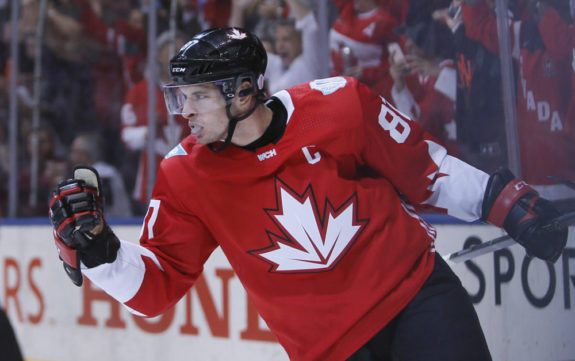In his 13 professional seasons, Sidney Crosby has done it all. He has three Stanley Cups, a gold medal at the World Cup of Hockey, and is a member of the Triple Gold Club with gold medals at both the World Championships and Olympics. He has produced four seasons of at least 100 point and a 50-goal season, and he has never finished a season averaging less than a point per game. He also has the awards with two Hart Trophies, two Art Ross Trophies, two Maurice “Rocket” Richard trophies, two Conn Smythe Trophies, and seven All-Star Game selections.

Despite all of that success, there is one achievement that has eluded Crosby. This season marks the first time that he has played a full regular season. Previously, his career high in games was 81 during the 2005-06 and 2009-10 seasons. At the other end of the spectrum, Crosby has had seasons when he missed at least 20 games, including 2010-11 and 2011-12 when he played a total of 63 games. The biggest reason is a lengthy injury history that cost Crosby time during his prime.
Crosby a Familiar Name on Injured Reserve
Although the majority of Crosby’s injuries were the results of concussion symptoms, his injury history started nearly three years before his first diagnosed concussion. His first appearance on injured reserve was in January 2008 following a high ankle sprain that cost him 21 games. At the 2011 Winter Classic, Crosby suffered his first diagnosed concussion that set off a series of lingering effects costing him nearly two full seasons over the next three years.
After the initial hit he received from David Steckel, Crosby played the next game but was subsequently checked from behind by Victor Hedman, which caused concussion-like symptoms, and he missed the remainder of the season plus the first 20 games of the 2011-12 season, returning on Nov. 21, 2011.
His second concussion occurred on Dec. 5, 2011 in a collision with David Krejci, and he missed 40 games recovering. After he returned on Mar. 15, 2012 he remained healthy until March 2013 when a Brooks Orpik shot broke Crosby’s jaw, and forced him to sit out 12 games. His third concussion occurred in October 2016 following the World Cup of Hockey and he missed six games to start the season. Finally, his fourth and most recent concussion occurred in the second round of the 2017 Playoffs but missed just one game.
In total, Crosby has missed 168 regular season games in his 13 seasons, just over two full seasons worth. Those 168 games represent 16.3 percent of the total 1,032 possible regular season games he could have played in. That doesn’t include him missing the 2011 Playoffs or the one game he sat out in each of the 2013 and 2017 Playoffs.
Looking back, it’s hard not to wonder what his injuries cost him in terms of production. He has over 400 goals and 1,100 points for his career and a majority of his injuries occurred between the ages of 23 and 25, prime playing years for forwards. That brings up the “what could have been” question had Crosby not missed so much time during his career.
What Could Have Been Sans Injury
Through the 2017-18 season, Crosby has 411 goals and 1,116 points, averaging 0.48 goals-per-game played (G/GP) and 1.29 points-per-game played (P/GP). If he maintained those averages for all 13 seasons and never missed a game, he would have 491 goals and 1,332 points. That is an additional 80 goals and 216 points in the 168 games missed. But, that’s not an appropriate way to project his production without injuries.

A more effective way is by looking at his scoring rates for each season and projecting that rate across a full 82-game season except for the lockout-shortened 2012-13 season. Looking at each season helps because league scoring rates have changed since Crosby’s first season, and because his individual scoring rates have fluctuated as well.
For example, between the 2010-11 and 2012-13 seasons, the three consecutive seasons when he missed the most time, he posted the three highest scoring rates of his career. In 2010-11 he averaged 1.61 P/GP in 41 games, in 2011-12 he averaged 1.68 P/GP in 22 games, and in 2012-13 he averaged 1.56 P/GP in 36 games. His 2010-11 and 2012-13 scoring rates were also highest in the league for those seasons.
Using individual season projections, Crosby would have 496 goals and 1,376 points in 1,032 games, raising his career scoring rate from 1.29 P/GP to 1.33 P/GP. Given his high scoring rates from 2010-11 to 2012-13, the largest additions to his career scoring totals would have happened during those seasons.
In 2010-11, he averaged 0.78 G/GP and 1.61 P/GP which project to 64 goals and 132 points in 82 games. For the 2011-12 season, he averaged 0.36 G/GP and 1.68 P/GP, equal to 30 goals and 138 points in a full season. During the 2012-13 lockout-shortened season, he averaged 0.42 G/GP and 1.56 P/GP. Had he played in all 48 games, he would have totaled 20 goals and 75 points.

Had he been healthy and maintained his scoring rates, Crosby would have more hardware to his name. Including the trophies he currently has, he would have a total of five scoring titles, including a run of three straight from 2010-11 to 2012-13, would have three Rocket Richard Trophies.
I recognize there is a chance that had Crosby not been injured, his scoring rates would have regressed across a full season. His 2010-11 season could have been an example of this. In league history, only 27 players have averaged at least 0.78 G/GP for a season—the same rate as Crosby in 2010-11—and played in at least 41 games. There were 50 total occurrences of such a season but 10 players performed the feat more than once.
Crosby was the most recent player to do so and only the fourth this century. Add in Crosby’s 1.61 P/GP from that season, and the number gets smaller. Just 27 times and by 13 players in league history has there been a season comparable to what Crosby did during 2010-11 before he was injured. Crosby’s instance is only the second one in the 21st century after Mario Lemieux did in 2000-01. Others with such seasons include Wayne Gretzky, Brett Hull, Phil Esposito, and Jari Kurri. Not including Crosby, of the 12 others with such a season, only three are not in the Hockey Hall of Fame.
So yes, Crosby may have regressed had he stayed healthy during the 2010-11 season and not had a 64goal, 132-point campaign for which he was on pace. But he also could have reached those levels and had one of the best seasons in history.

Crosby’s name belongs with those listed above. When he retires, he will be among the top 15 players to ever play and will be inducted into the Hall of Fame on his first ballot. Like Gretzky, Lemieux, and Eric Lindros before him and Connor McDavid after him, Crosby entered the league as a generational player with great hype and lived up to it. He is fifth among active players in points and only he and Alex Ovechkin are in the top five and started their careers after 2000.
But, even with his accolades and lofty scoring totals, it is difficult to not be left with a sense of “what if?” when reflecting on his career. Similar to how we view Jaromir Jagr, who missed time because work stoppages and playing in the KHL, both are all-time greats whose careers were unable to live to their fullest.
If Crosby had a career not shortened by injuries, I feel confident there would no longer be a debate over the best Pittsburgh Penguin in franchise history: him or Lemieux (also a “what if?” career). It would be Crosby. He’d have seven scoring titles, second-most all-time, three Rocket Richard Trophies, also second all-time, and at least three MVPs, tied for the fourth-most. He’d not only be the best player of his generation but one of the best ever to put skates on, a player who forever changed the game.
What are your thoughts about Crosby’s career and what might have been had he not suffered numerous concussions? Let me know in the comments.
*All stats and information came from Hockey-Reference